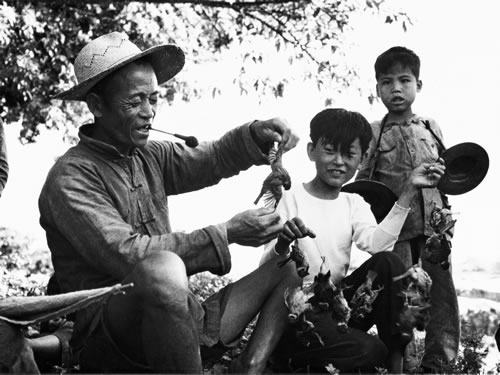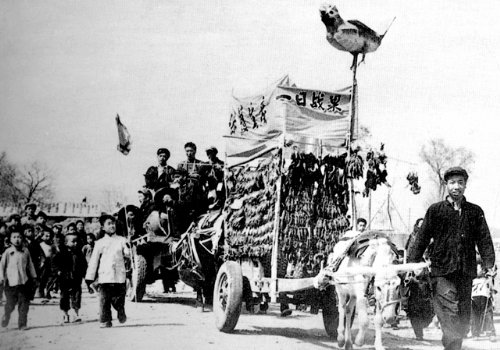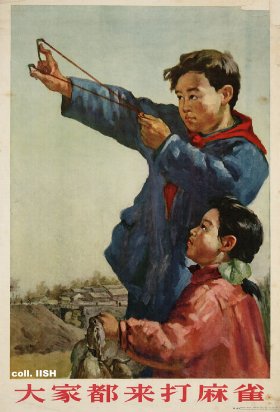The Chinese Sparrow War of 1958
(New Century Net) The Chinese Sparrows of 1958. By Sha Yexin. August 31, 1997.
Any living organism cannot avoid disasters and catastrophes, no matter whether it is a rat scurrying across the street, a fly hitting the wall, a dog losing its home, a rabbit having its warren destroyed, an ant crawling in a hot pot, a fish in a dried pond, a turtle trapped in a jar or a lamb in the tiger's jaws. But none have ever encountered a disaster on the scale of that which fell upon the Chinese sparrows in 1958. That catastrophe was practically almost enough to extinct the species. The disaster was not a natural one; rather, it was a manmade one. In the entire history of sparrows around the world, they have never been embroiled in a people's war as they were in China in 1958.
In the history of people's wars in China, there are two extraordinary episodes. In the first war, the superbly equipped 8-million-strong Kuomintang army was slowly chewed up by the small-caliber rifles of the Communists. The second war was the 1958 war against the sparrows in China. On December 13, 1958, in Shanghai alone, the most primitive weapons were used to destroy almost 200,000 sparrows. How many died across the nation in total? Probably at least 8 million? What do you think about the human's ability to conduct war?
Let use look at the Shanghai newspaper on that day. The headline was, "The whole city is attacking the sparrows." The news story was quite lively, so that we can still feel the heat of the battle when we read it today.
"On the early morning of December 13, the citywide battle to destroy the sparrows began. In large and small streets, red flags were waving. On the buildings and in the courtyards, open spaces, roads and rural farm fields, there were numerous scarecrows, sentries, elementary and middle school students, government office employees, factory workers, farmers and People's Liberation Army shouting their war cries. In the Xincheng district, they produced more than 80,000 scarecrows and more than 100,000 colorful flags overnight. The residents of Xietu road, Xuhui distrct and Yangpu road Yulin district also produced a large number of motion scarecrows. In the city and the outskirts, almost half of the labor force was mobilized into the anti-sparrow army. Usually, the young people were responsible for trapping, poisoning and attacking the sparrows while the old people and the children kept sentry watch. The factories in the city committed themselves into the war effort even as they guaranteed that they would maintain production levels. In the parks, cemeteries and hot houses where there are fewer people around, 150 free-fire zones were set up for shooting the sparrows. The Nanyang Girls Middle School rifle team received training in the techniques for shooting birds. Thus the citizens fought a total war against the sparrows. By 8pm tonight, it is estimated that a total of 194,432 sparrows have been killed."
I went back to read my diary back then. In 1958, I went with the Department of Chinese at the Huadong Normal University to Commune Number 4 in Huating town, Jiading county for revolutionary education. I was living in Hujia village. On December 13, my diary entry was: "The city government decided to kill the sparrows today, including in the rural outskirts. In the morning, we were divided into the three teams to fight in this war. In the afternoon, we were also divided into teams to continue the war." In retrospect, it would seem that I was being very sketchy about a great historical episode, and therefore I have let history down. As I recalled, my fellow students and I climbed onto some tall trees on the side of the road and banged our gongs, drums, washbasins and anything else that could make loud noises. The sparrows were forced to keep flying until they dropped dead from fatigue. If the millions of dead sparrows had been autopsied, I dare say that 90% of them died from sudden cardiac arrest (from fatigue or fright).
Just as the three great battles in the war of liberation were personally ordered and directed by the Great Leader, this people's war against the sparrows was also personally ordered and directed by his esteemed self. Between March and May, 1958, he conducted central government work conferences in Chengdu, Wuhan and Guangzhou and also at the Second Plenum of the Eighth Congress of the Chinese Communist Party. He called for the eradication of the sparrows, one of the four pests. He said: "Here is the method -- we make our resolution, we coordinate our actions, we divide our tasks, we cut off the food supply, we set up a trap and we continue our battle of destruction." Physical force needed to be complemented by propaganda tools to motivate the people. Thus, he wanted people to write many folk songs. I tend to think that writing folk songs is just as well-intentioned as the war against the sparrows. Concerning these folk songs, he said: "Everyone will be given three or five pieces of paper for them to write folk songs. We have more than 90,000 towns around China. If each town can publish one collection of folk songs, we would have 90,000 different books. In order to surpass our quota, our school leaders even asked us to write at least 10 folks songs a day! If they can grow 10,000 jin of crops on one mu of land during the Great Leap Forward, then why can't you write ten folk songs a day? Fine. Let's write; if you can't, then you must make something up. So I made up this song on the day of the war against the sparrows.
"The entire people is mobilized together. The sparrows have been wiped out, the mosquitoes have fled to Fujian while the flies are hiding in Guangdong."
There is obviously some element of local protectionism in that. Frankly speaking, it deserved to be criticized.
This disaster against the sparrows was finally terminated in 1959 when the Academy of Sciences leaders brought up the opinions of scientists such as Zhu Xi and Zheng Zuoxin. The scientists had autopsied the digestive systems of the sparrows and found that three-quarters of the contents were harmful insects and only one-quarter was human food. This showed that sparrows were basically a beneficial bird for humans.
Sparrows have flaws just like intellectuals. When they jump on the flagstaff, they look self-important. They also like to chirp when they are in charge, just like intellectuals like to talk. They are also disinterested in politics and lack deep visions, as they are content just to own a home. But ultimately sparrows can catch harmful insects and fulfill their functions, just as intellectuals can toil honestly and do what they are good at. So their contributions are greater than their flaws, say in a 30%/70% ratio. Although the sparrow is tiny, it has all the body organs and it is also an essential member of the ecology. So how could we butcher them? There may a few misbehaving individuals, but that is just a very small number for which there is no reason to mobilize the entire human population to eradicate the entire species.
Last year was the thirtieth anniversary of the Cultural Revolution. This year is the fortieth anniversary of the Anti-Rightist campaign. Both of these events passed by quietly in this peaceful atmosphere. Next year will be the fortieth anniversary of the Great Sparrow Disaster. Can we commemorate it from either the viewpoint of protecting the ecological environment or making policies on the basis of democracy and scientific data? History should not be forgotten!
(TIME) Death to Sparrows. May 5, 1958.
"No warrior shall be withdrawn until the battle is won," proclaimed the Peking People's Daily. "All must join battle ardently and courageously; we must persevere with the doggedness of revolutionaries." Into battle, thus exhorted, went the Chinese millions to wage war on the lowly sparrow.
At dawn one day last week, the slaughter of the sparrows in Peking began, continuing a campaign that has been going on in the countryside for months. The objection to the sparrows is that, like the rest of China's inhabitants, they are hungry. They are accused of pecking away at supplies in warehouses and in paddyfields at an officially estimated rate of four pounds of grain per sparrow per year. And so divisions of soldiers deployed through Peking streets, their footfalls muffled by rubber-soled sneakers. Students and civil servants in high-collared tunics, and schoolchildren carrying pots and pans, ladles and spoons, quietly took up their stations. The total force, according to Radio Peking, numbered 3,000,000.
At 5 a.m. bugles sounded, cymbals crashed, whistles trilled. The massed students beat their kitchenware and advanced, as Radio Peking recounted, singing a rousing, revolutionary anthem: "Arise, arise, Oh millions with one heart; braving the enemy's fire, march on."
The massive extirpation force netted and scatter-gunned the exhausted birds or snared them with long, gum-tipped bamboo poles. At last report 310,000 sparrows had fallen in Peking alone, and an estimated 4,000,000 throughout the rest of Red China. The national hero was Yang Seh-mun, 16, of Yunnan. He had killed 20,000 sparrows by sneaking around during the day locating nesting trees. At night, China Youth proudly reported, he then climbed trees and strangled whole families of sparrows with his bare hands.

Xiamen, Fujian 1958 (kkxx365)

“社员同志们,消灭麻雀是毛主席、党中央交给咱的政治任务,咱大队要家家户户齐动员,
男女老少都上阵,做到人人手里有弹弓,不会使弹弓的就敲铜锣,
没有铜
锣的就敲脸盆,没有脸盆的你就扯脖子喊,喊,人人都会,是不?
干啥啊?你说干啥?就为了吓唬麻雀那狗东西!
大家要记住一条,不让麻雀落地,落树枝上、房檐
上也不行,
累死那些个糟蹋粮食的小兔崽子!”
(《旧事》第7期)
(kkxx365)

Everybody get together to hunt sparrows
(Stefan R. Landsberger)
麻雀麻雀气太官,天垮下来你不管。
麻雀麻雀气太阔,吃起米来如风刮。
麻雀麻雀气太暮,光是偷懒没事做。
麻雀麻雀气太傲,既怕红来又怕闹。
麻雀麻雀气太骄,虽有翅膀飞不高。
你真是混蛋鸟,五气俱全到处跳。
犯下罪恶几千年,今天和你总清算。
毒打轰掏齐进攻,最后方使烈火烘。
连同武器齐烧空,四害俱无天下同。
—— 1958年4月21日《北京-晚报》《咒麻雀》